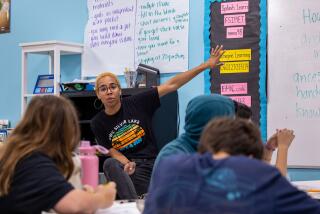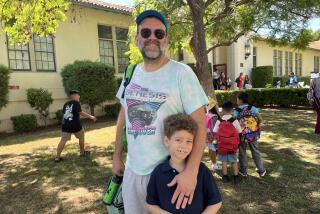L.A. Schools Take Pains to Cope With Tragedy
The students in the first-grade class at Figueroa Street Elementary School sat in their tiny chairs, clustered around their teacher. On the chalkboard behind her was the current events lesson for the day: history as a primer.
The Space Shuttle exploded up in the air.
A shuttle is a spaceship with two missiles on the side of it.
Astronauts fly in a space shuttle.
The rocket exploded.
Seven people died.
“The way I wrote it on the board is the way they told it,” teacher Daisy Redic said.
New Vocabulary Words
On the day after the space shuttle Challenger blew apart, killing a crew that included New Hampshire schoolteacher Christa McAuliffe, Redic had chosen to use the tragedy as a means of teaching her pupils some new vocabulary words and something about life.
Flags flew at half-staff at many schools Wednesday as educators in Los Angeles and throughout the nation took different tacks in reacting to a news event that struck very close to home.
Often, teachers brought the tragedy into the classroom. Talking is a good way to deal with it, teachers and psychologists agreed.
“The basic principle is to get out truthful information and have the students, especially the younger ones, understand that the adults are still in control and that the world is not falling apart,” said Julia Wright, a member of the Los Angeles Unified School District psychological crisis team that was put on alert hours after the shuttle accident.
The crisis team--composed of psychologists, counselors and nurses--contacted
‘Symptoms of Trauma’
“We wanted to let everyone in the district know what services were available, the symptoms of trauma that students might show and the materials that the district has made available that teachers can use in the classroom to help students understand what has happened,” said Loeb Aronin, coordinator of psychological services for schools in the San Fernando Valley.
“Younger children might have eating problems, sleeping problems, exhibit regressive or more babyish kinds of behavior,” he continued.
At the Sherman Oaks Center for Enriched Studies, administrators and teachers took the team’s advice to talk openly about the destruction of the shuttle. A schoolwide assembly was held Wednesday morning.
At the Open School, a Westside magnet school, Principal Roberta Blatt said teachers encouraged their students to write letters to astronaut McAuliffe’s family and the students at her Concord, N.H., high school.
At the Figueroa Street school, Redic led her multicultural, bilingual students in a discussion.
“Who were the people on the space shuttle? . . . Were they all men?”
“No!” the students called out.
“Right . . . There were two women . . . and there was a black man, and an Oriental man.”
In the early days of space the program, neither women nor blacks were astronauts, Redic explained.
“But now, all of us can do different kinds of jobs,” Redic told her students. “All you need is to train and be a good worker.”
Redic pointed to the chalkboard. “Now, is this true? . . . Yes. This is not a story. Now, what do we call things that are true? . . . We say it’s real. It happened for real.”
The teacher paused.
“Now,” she called out, “how many people learned new words?”
She pointed to a few words on the board: shuttle, missiles, astronauts, died. The students said the words aloud.
More to Read
Sign up for Essential California
The most important California stories and recommendations in your inbox every morning.
You may occasionally receive promotional content from the Los Angeles Times.










